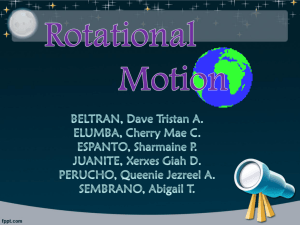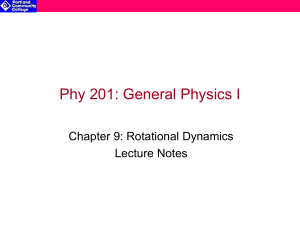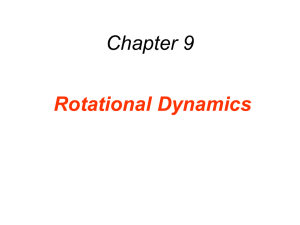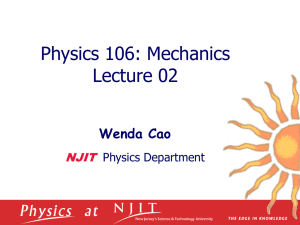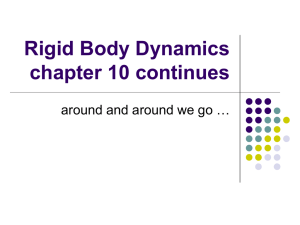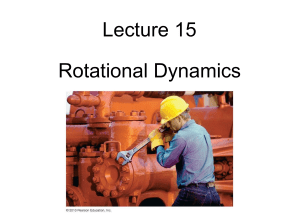Powerpoint slides
advertisement
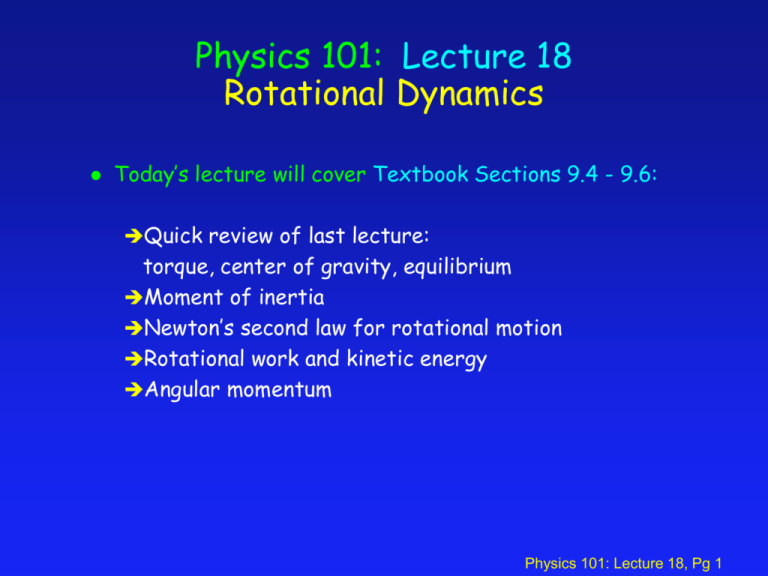
Physics 101: Lecture 18 Rotational Dynamics Today’s lecture will cover Textbook Sections 9.4 - 9.6: Quick review of last lecture: torque, center of gravity, equilibrium Moment of inertia Newton’s second law for rotational motion Rotational work and kinetic energy Angular momentum Physics 101: Lecture 18, Pg 1 Torque and Equilibrium Find Mpaint so that plank is in equilibrium. d1 Find total torque about this axis d2 d3 FA Mpaintg mg Mg t(mg) = mgd1 t(FA) = 0 t(Mg) = -Mgd2 t(paint) = -Mpaintgd3 Total torque = 0 = mgd1 –Mgd2 - Mpaintgd3 Thus, when Mpaint=(md1-Md2)/d3 then the plank is in equilibrium. Physics 101: Lecture 18, Pg 2 Moment of Inertia When torque is the analogue of force what is the analogue of mass or what is the measure of inertia of a rigid body in rotational motion about a fixed axis ? Consider a tangential force FT acting on a particle with mass M rotating on a circular path with radius R. The torque is given by t = FT R = M aT R = M a R R = (M R2) a I=M R2 is called the moment of inertia of the particle. For any rigid body : I= S (m r2) SI unit: [kg m2] Any rigid body has an unique total mass, but the moment of inertia depends on how the mass is distributed with respect to the axis of rotation. Physics 101: Lecture 18, Pg 3 Moments of Inertia of Common Objects Hollow cylinder or hoop about central axis I = MR2 Solid cylinder or disk about central axis I = MR2/2 Solid sphere about center I = 2MR2/5 Uniform rod about center I = ML2/12 Uniform rod about end I = ML2/3 Physics 101: Lecture 18, Pg 4 Concept Question The picture below shows two different dumbbell shaped objects. Object A has two balls of mass m separated by a distance 2L, and object B has two balls of mass 2m separated by a distance L. Which of the objects has the largest moment of inertia for rotations around the x-axis? m 1. A CORRECT 2. B 2m 3. Same 2L L x 2m m A I = mL2 + mL2 = 2mL2 B I = 2m(L/2)2 + 2m(L/2)2 = mL2 Physics 101: Lecture 18, Pg 5 Newton’s 2nd Law If a net torque is applied to a rigid body rotating about a fixed axis, it will experience an angular acceleration: S text = I a a in rad/s2 For the same net torque, the angular acceleration is the larger the smaller the moment of inertia. Physics 101: Lecture 18, Pg 6 Rotational Work and Kinetic Energy Work done by a constant torque in turning an object through an angle q : WR = t q q in rad SI Unit: [J] Translational kinetic energy: KEtrans = 1/2 m v2 Rotational kinetic energy: KErot = 1/2 I 2 in rad/s SI Unit: [J] Rotation plus translation: KEtotal = KEtrans + KErot = ½ m v2 + 1/2 I 2 Physics 101: Lecture 18, Pg 7 Conservation of Mechanical Energy The total mechanical energy for a rigid body with mass m and moment of inertia I is given by the sum of translational and rotational kinetic energy and gravitational potential energy: E = KEtrans + KErot + E pot = = ½ m v2 + ½ I 2 + m g h If the work done by non-conserving forces and torques is zero, the total mechanical energy is conserved (final equals initial total energy) : Ef = E0 if Wnc=0 Physics 101: Lecture 18, Pg 8 Angular Momentum The rotational analogue to momentum (1-dim: p = m v) in linear motion is angular momentum: L=I in rad/s SI unit: [kg m2/s] Conservation of Angular Momentum: If the net average external torque is zero, the angular momentum is conserved, i.e. the final and initial angular momenta are the same : Lf = L0 if S tave,ext = 0 Physics 101: Lecture 18, Pg 9 See text: chapters 8-9 Rotation Summary (with comparison to 1-d linear motion) Angular a = constant, t0=0s = 0 + a t q = q0 + 0 t + ½ a t2 2 = 02 + 2 a (q-q0) Linear a = constant, t0 =0 s v = v0 + a t x = x0 + v0 t + ½ a t2 v2 = v02 + 2 a (x-x0) St=Ia W=tq KErot 1 I 2 L2 / 2 I 2 L=I See Table 8.1, 9.2 SF=ma W=Fs KEtrans 1 mv 2 p 2 /( 2m) 2 p=mv Physics 101: Lecture 18, Pg 10






